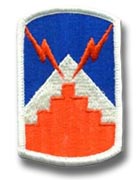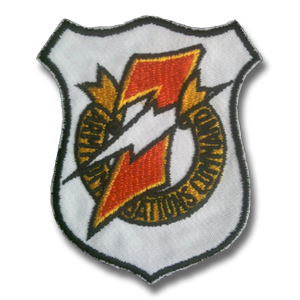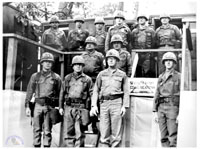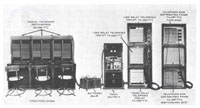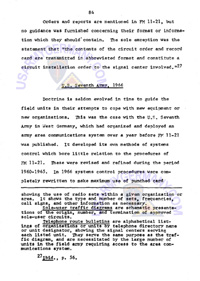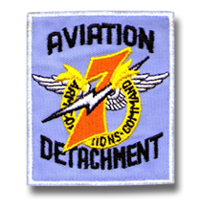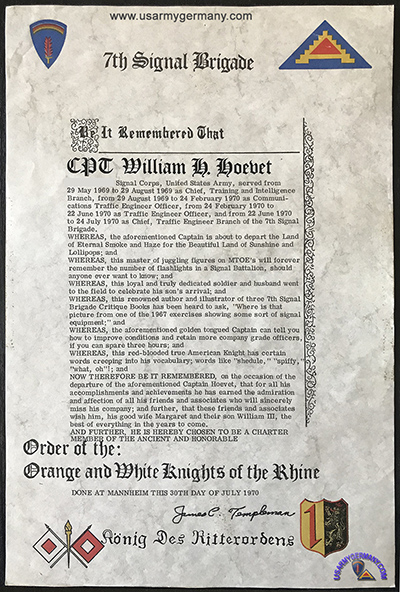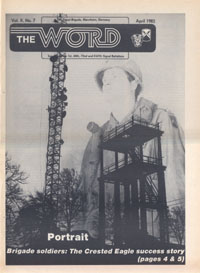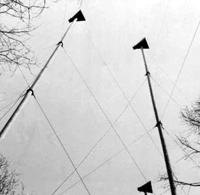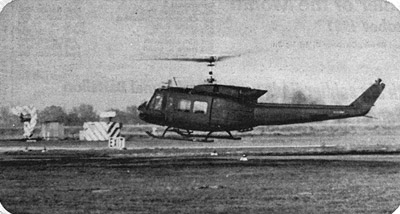| If you do
NOT see the Table of Contents frame to the left of this page, then
Click here to open 'USArmyGermany' frameset |
|||||||||||||||||||||||||||
|
7th Signal Brigade |
|||||||||||||||||||||||||||
|
|
|||||||||||||||||||||||||||
|
|||||||||||||||||||||||||||
|
|
|||||||||||||||||||||||||||
| 7th Army Communications Command History | |||||||||||||||||||||||||||
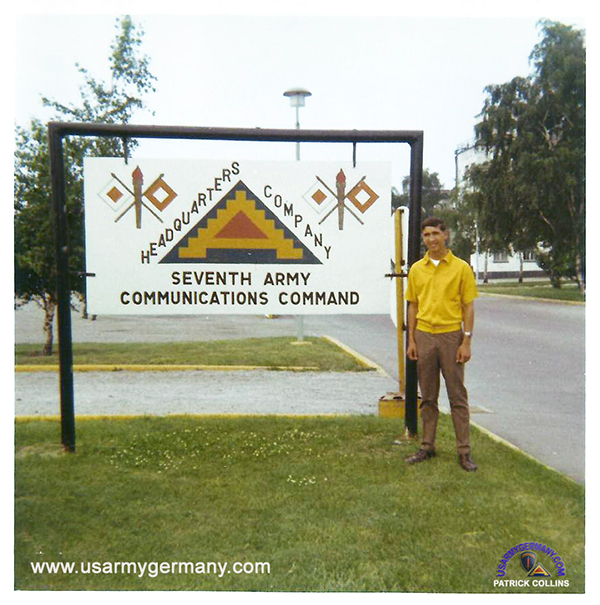 Hq Co 7ACC sign in front of company barracks, Coleman Barracks |
|||||||||||||||||||||||||||
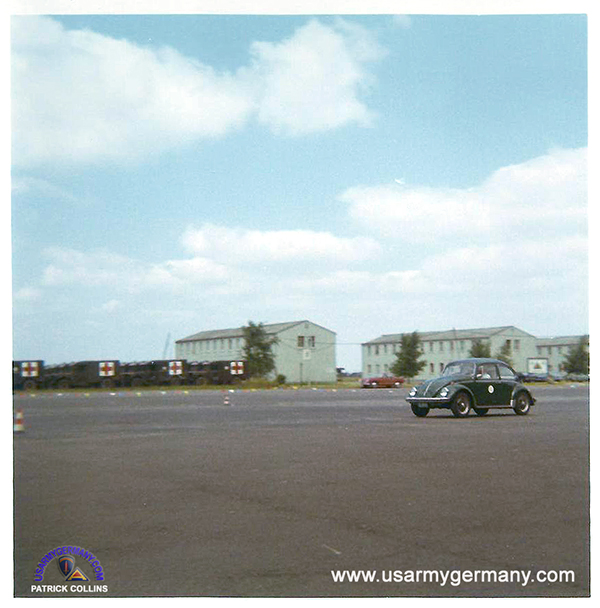 7ACC barracks in background, Coleman Barracks, 1969 (Patrick Collins) |
|||||||||||||||||||||||||||
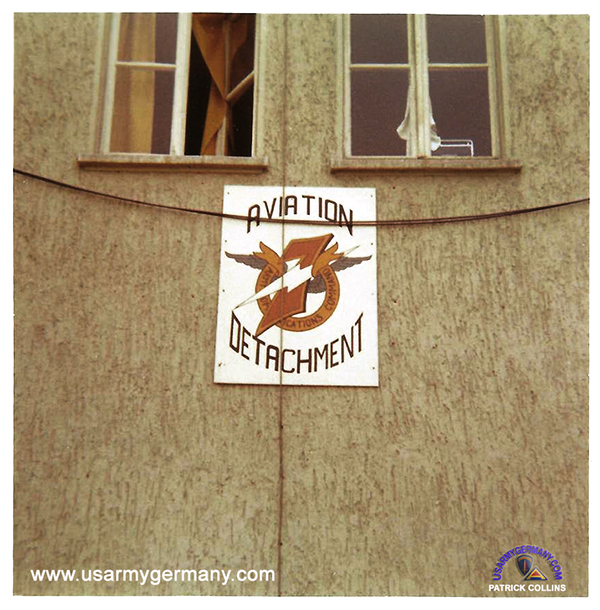 Aviation Detachment, 7ACC, Coleman Barracks, 1969 (Patrick Collins) |
|||||||||||||||||||||||||||
 UH-1 of Avn Section, 7th Sig Bde, Coleman Barracks, early 1970s (Michael Routh) |
|||||||||||||||||||||||||||
|
|||||||||||||||||||||||||||
|
|||||||||||||||||||||||||||
| 1966 | |||||||||||||||||||||||||||
| (Source: Email from Robert Stovall, 97th Sig Bn and 7th Army Communications Comd, 1966-70) | |||||||||||||||||||||||||||
| See also Robert's email on the 97th Sig Bn Page. | |||||||||||||||||||||||||||
| I was a member of the 7th Army Communications Command. I transferred there from the 97th Sig Bn (where I was Btn Adjutant). My first assignment was to S3, Operations, where I wrote exercise plans, then to Signal Systems Engineering. One of the "side benefits" of Systems Engineering job was that I became the signal briefing officer. I briefed Col. John Morrison and the staff 6 days a week, and in the field I was the briefer to the CG 7th Army and staff, plus visiting dignitaries. Some interesting times. If I recall correctly, I briefed Melvin Laird when he was Sec. Def. Seems like Col Morrison made me practice for him for 8 hours. Really a PITA, but we got it done flawlessly. Had a 1LT working with me, Harry Midgely, in case that name comes up somewhere. We kept in touch after I rotated out. I think he took my job, not sure. Let me recall for you one interesting story. We went on full alert for an exercise one time and the whole of the 7th Army went to the field. I can recall some interesting stuff on the deployment (screw ups mostly) but the signal briefing was very "memorable". At the first field briefing -- 12 hours after the balloon went up -- all the other staff guys went first in the briefing to the CG. I think it was General Heintges... but I may be wrong. In any case every staffer stood up and had a tale of woe.... G1 said he could not give troop counts because signal was not working. G2 said he had no intelligence because signal was out. G3 said the same. G4 said the same. I stood up and briefed the signal status, which was basically, sorry, but the main backbone systems were still not up and we did not know when they would be up. I thought Col Morrison was going to crawl under the chair. Gen Heintges said son, let me say a word or two... He stood up and said "Gentlemen, I have just come here from Viet Nam. Let me tell you -- this is the best signal you will ever have in real combat. Now every one of you has a jeep or a staff car. Now get your ass in it and go find out what you need to know to run this war and be ready to brief me in 12 hours". They high-tailed out of there like rabbits. He turned to me and said, "Son, you have 12 hours to get that signal up or we will have a real problem". We did it, too. As I recall, the 7th Army Communications Command, had 5 signal battalions reporting, plus HQ/HQ Company. |
|||||||||||||||||||||||||||
|
|||||||||||||||||||||||||||
|
|||||||||||||||||||||||||||
| The TTC-7 was a group of 3 smaller switchboards. There were like 4 of them in the vans... that's 4 groups of the 3 little ones. | |||||||||||||||||||||||||||
| 1967 | |||||||||||||||||||||||||||
| (Source: A proposed Doctrine for Field Army Communications Control, by Clare R. J. Rogers, MAJ USA, 1967) | |||||||||||||||||||||||||||
|
|||||||||||||||||||||||||||
| Reorganization Effective Today, By Spec. 4 Ben Martineau, October 1981 | |||||||||||||||||||||||||||
| Today the 7th Signal Brigade comes under the command of the 5th Signal Command. This reorganization was undertaken to realign all signal units in USAREUR at Echelons Above Corps under one command, according to Capt. Robert C. Clouse, 7th Signal Brigade Organizational Effectiveness Management Consultant. Clouse, who is the central point of contact on the transition, expects the reorganization to have little effect on the majority of the personnel in the brigade. "Our mission will stay the same. Most folks won't even notice the changes," he explained. However, as with any command change, minor adjustments are expected. But according to most people in the 7th Signal Brigade, these will be worked out once everyone becomes adjusted to the new requirements that the 5th Signal Command will need for their reports. Personnel's view Sgt. 1st Class Paul A. Slater, NCOIC of the Brigade's Personnel Section, expects that one change will be the turnaround time for some types of personnel actions in the brigade. As an example, with the 5th Signal Command now being the approving authority for foreign service tour extensions, reassignments and related actions, members of the 7th Signal Brigade will now have to allow more time for these types of actions. "However, if personnel actions are submitted on time, there should be no problem. "On the other hand, the turnaround time for awarding the Army Commendation Medal should be faster because the 5th Signal Command has the approving authority," Slater said. Although the work load in personnel will increase with the reorganization, Slater explained that the impact will be minimal on individuals needing personnel actions. Capt. George F. Morgan Jr., 7th Signal Brigade Intelligence Officer, sees positive results with the reorganization as it effects security matters. "Overall the reorganization is good for security. It will bring about a tighter security program than we have now, and that's good. More people will be aware of security and hopefully will be more conscientious," Morgan explained. He also expects to see more training and in-briefings on security matters. Lt. Col. Patrick J. McWherter, S-3 Operations Officer, sees no change in the brigade's mission of "Getting the Word to the Man." McWherter stated that he believes our mission accomplishment will be enhanced as 5th Signal Command assets and capabilities are added to ours. "Being an integral part of the 5th Signal Command will reduce the potential for misunderstandings because we'll be operating from the same sheet of music," McWherter explained. McWherter said that the most important aspect of the reorganization is that it will help all communicators understand that our mission is dependent upon every other communicator, from the combat wireman all the way up the ladder to the most senior Pentagon Signal Officer. Lt. Col. Robert L. Bober, S-4 Logistics officer, expects no major changes in the services supported by his section. He said that there will be an adjustment period because some of the logistics support that the 7th Signal Brigade provides are new to the 5th Signal Command, such as running large dining facilities. "We'll still be supported by USAREUR in some areas. It has to be that way. Even the 5th Signal Command gets some support from USAREUR, " Bobar said. He explained that the overall concept under one command would, in the long run, help people receive communications support. Bobar added, "The folks at the 5th Signal Command have been real good to work with. We've received all the support possible from them. This move cannot help but improve both of our respective units." The reorganization under the 5th Signal Command will necessitate an educational period by both the 7th Signal Brigade and the 5th Signal Command. This realignment was undertaken to bring both the tactical and fixed stations signal people under one command in Europe because we are all involved in performing basically the same mission. |
|||||||||||||||||||||||||||
| 1968 | |||||||||||||||||||||||||||
| (Source: Email from Rodger Fetters) | |||||||||||||||||||||||||||
|
|||||||||||||||||||||||||||
| I have no idea when the Avn Det 7th Army Communications Command was started. Other than basic transportation for the commander and his staff, we were used as an airborne patform for radio relay. They used all kinds of configurations and some really looked strange. We had antennas that were supposed to be installed on wheeled vehicles hanging from bomb racks on the U-6 and a smiliar set up on the CH-34's Two ground type radios were set up on a rack that replaced one of the U-6 passenger seats. The 7th ACC had seven signal battalions assigned all over Germany. Our little detachment was sujpposed to be headed up by a Captain and a SFC E-7 and consisted of about 10 officers and warrant officers and 20 EM. Of course the TI and the CH-34 CE's were Sp6 positions. Amazingly, we had one two year draftee that was a CH-34 CE that actually made Sp6 during his two years of active duty. Now that was really strange!!! As you probably know, Vietnam caused some huge shortages in aviation personnel and those that were NOT there were more or less standing three deep (or more) When I arrived at the 7th ACC, we had something like 5 or 6 E-7's! I never thought I would ever get a promotion there but when I was with the 179th, my previous Chinook company in Vietnam, my maintenance officer told me that he would NOT promote me because he needed me as a TI and and would not do that because if he did, I would be reassigned but he would give me a high recommendation. At that time, all promotions for E-7 E-8 and E-9 were being consolidated at DA level. In February 1969, there I was in the 7th ACC and the orders came down from DA that all those with the recommendations would be promoted ONE TIME regardless of slots more or less to get a fresh start on army wide promotions at the DA level. That is how I made E-7 and I can tell you there were a couple of other E-6's there that were disappointed (to say the least) Like I said, by May of 1969, I knew that my tour of duty in Germany would not be anywhere close to two years! I was back in Vietnam the day that the first guys set foot on the moon. 20 Jul 69.
Can you tell me specifically when and under what circumstances the "Field Maintenance Detachments" faded into history? I was with the 93rd Trans and they had the 80th TC and later on 6th Trans in Korea and ours was the 150th. Later on in Vietnam I was with the 179th Avn and ours then was the 402nd TC. That was 1967-68 but when I arrived in Vietnam for my second tour at the 213th Avn, there was no detachment. Instead we had a "Service Platoon." |
|||||||||||||||||||||||||||
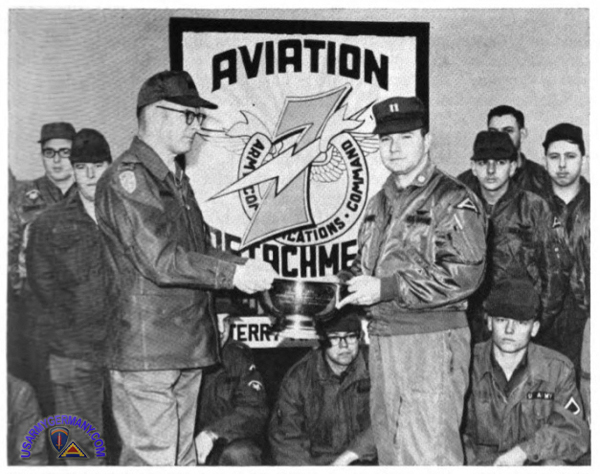 Col John H. Morrison, Jr., CO of 7ACC, presents Capt Terry M. Tate, CO of 7th ACC's Aviation Department, with a silver cup for having recently been selected as the most outstanding detachment-size aviation unit in USREUR for 1968 (SIGNAL) |
|||||||||||||||||||||||||||
| 1969 | |||||||||||||||||||||||||||
| (Source: SIGNAL, September 1969) | |||||||||||||||||||||||||||
| AVIATION DETACHMENT, 7th ACC When Wilbur and Orville Wright first saw their awkward bundle leave the ground, it is generally agreed that they had no idea what they were starting. After all, what worthwhile purpose could be served by a one-man vehicle, even if it could fly? But before long, someone suggested using the airplane in a tactical military situation. This, however, met more scorn than encouragement. In fact, when the airplane was demonstrated to Field Marshall Foch, later the Commander of French Forces, he referred to it as ". . . nice, but of no military value." Field Marshall Foch was wrong, but so were a lot of other people. Only a few men, such as Billy Mitchell, saw the value of a military Air Force. Eventually, military leaders began to use the airplane for reconnaissance, and the Signal Corps became the original father of Army Aviation. As the use of aircraft became more acceptable and eventually indispensable to the military, aviation outgrew the Signal Corps and took on an identity of its own in the military world. It is ironic, therefore, that a Signal Corps Aviation Detachment should be selected as the "most outstanding aviation detachment in United States Army Europe for 1968." There remains little to remind us of Army Aviation's Signal Corps heritage today except for a few small, scattered units around the world. One such unit belongs to Seventh Amy Communications Command (7ACC), the "nerve center" of Seventh Army. and is located near Mannheim, West Germany. When the Army Aviation Association of America (AAAA), European Region, held its annual awards ceremony in Garmisch, West Germany, this past February, representatives from aviation units all over Europe were present for the awarding of outstanding units throughout the European Command. The fact that 7ACC's Aviation Detachment was chosen to be the best aviation unit in all of USAREUR was evidence enough to point out the importance of aviation in the Signal Corps. More than 50 units competed for this honor against very high entrance criteria. The Aviation Detachment serves as a unique link in the overall effectiveness of 7ACC's operational mission. On any one day, requirements may range from making command and liaison visits to adjacent and supported corps headquarters of Seventh Army to delivering critical radio equipment and / or repair parts to isolated hilltops and field positions not accessible by other means of transportation due to weather or terrain. In area, the job covers a large part of Germany. With communications units strategically deployed over vast regions throughout USAREUR, time and distance become imposing factors in the effective command of Colonel John H. Morrison, Jr.. 7ACC Commanding Officer. "Our job at 7ACC," explains Colonel Morrison, "is to plan, engineer, install, operate, control and maintain the Army Command and Area Communications System for Seventh Army." Seventh Army Communications Command, the only signal command of its kind in the Army, is primarily composed of an Army signal battalion that supports Seventh Army Headquarters and five combat area signal battalions. With these battalions deployed in a vast network of communications throughout the Seventh Army area of Germany, it is easy to see why Colonel Morrison regards his aviation detachment so highly. "With this capability," Colonel Morrison says, "Our Army Area Signal Centers and other remote signal sites which are set up in the mountains and forests are almost its accessible to me as the garrison headquarters which are located alone the autobahns." |
|||||||||||||||||||||||||||
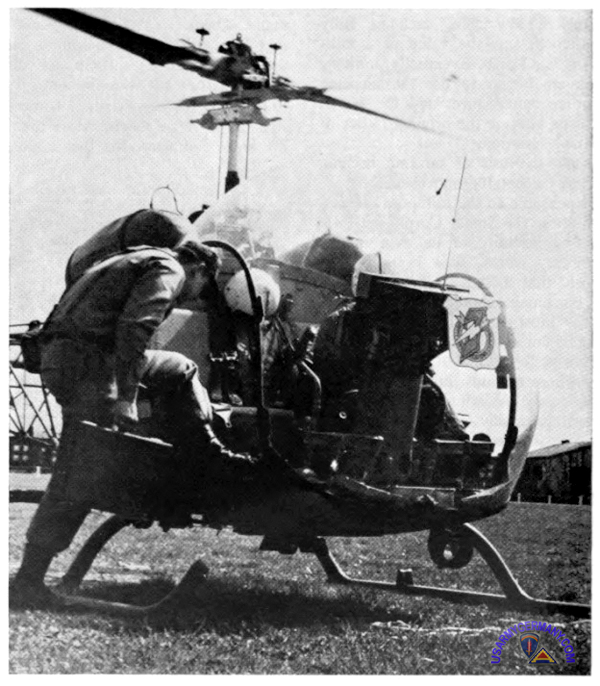 Providing 7ACC with fast and effective message and courier service as well as resources supply are only a few of the many aviation detachment functions (SIGNAL) |
|||||||||||||||||||||||||||
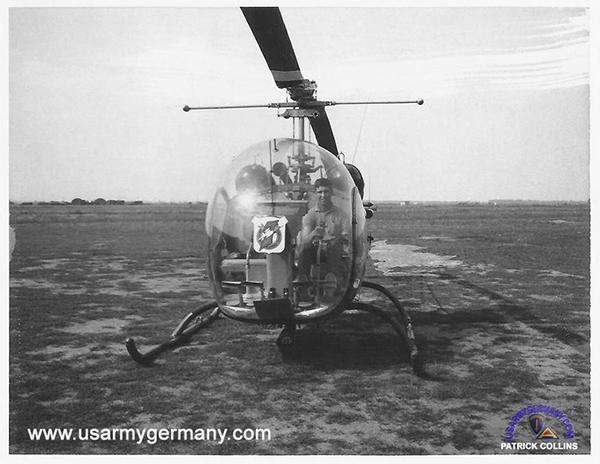 H-13 of Aviation Detachment, 7ACC, Coleman Barracks, 1969 |
|||||||||||||||||||||||||||
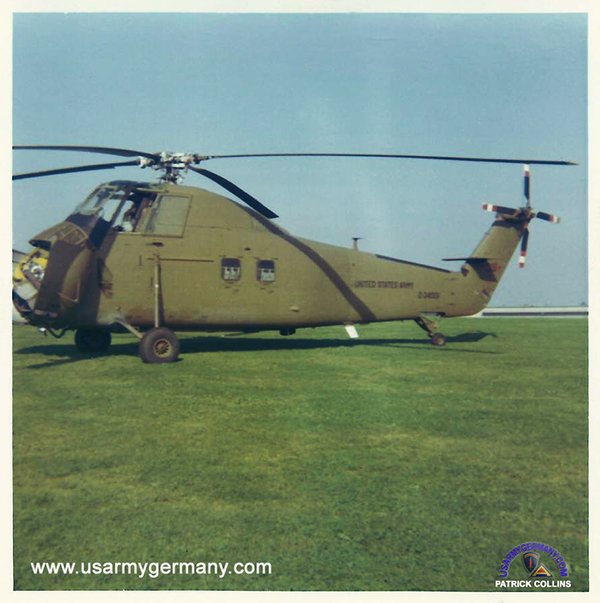 One of the Avn detachment's H-34's at Coleman Barracks, 1969 |
|||||||||||||||||||||||||||
| But Colonel Donald A. Beyer, Deputy Commander, is eager to say that this accessibilily is not at all limited to personal contact by the commander. Messenger service, he points out, is a big job of the aviators, not only for command message traffic, but for the additional administrative and logistic information that must be processed to keep an army well-informed and supplied in the field. Many times, air courier is the best way to "get the message through." But the job is signal. First and foremost, it is signal. As a result, the Seventh Army Communications Command aviators may be called upon to perform the most basic of signal functions, keeping the circuits on the air. Often this requires a piece of equipment or a maintenance technician at a particular place and in a hurry. Overall, 7ACC's aviation unit's mission remains the same as its Vietnam counterparts, except that it is geared for a slightly different concept of command support. In a very real sense, each man must maintain a tactical capability and is trained to think and react under any situation. Flight Qualified Despite a shortage of fixed-wing pilots in 1968, the aviation detachment exceeded its 1967 flying-hour rate by logging 1,687 hours with both helicopter, and fixed-wing aircraft. Good Job Spirit of Flight |
|||||||||||||||||||||||||||
| (Source: Email from William H. Hoevet, 1969-1970) | |||||||||||||||||||||||||||
| I arrived in Europe (Seventh Army Communications Command) in May of 1969 and was assigned Chief of Training and Intelligence; however, I did not function in that slot and always had an office in the Plans Department under Major Robert Maus and later Major Claiborne. I immediately became responsible for writing speeches primarily for Colonel John Morrison, 7A Communications Command (TDA) and Colonel Ralph Younger, Operations Officer for the Command and was responsible for the Command Briefing which principally involved traveling to the 5 Area Signal Battalions and briefing personnel on our mission. Our headquarters at Coleman Barracks, Mannheim/Ludwigshafen and its subordinate units (including the air wing, messenger) provided all high level tactical communications to the V and VII Corps, 32d AADCOM and the 56th Artillery Group. While having other assigned duties, plans for me was mostly about communicating the mission of our command. After a couple of months, a Lieutenant with radio announcing experience joined the command and relieved me of the responsibility of giving most of the briefings; however, I retained the responsibility of writing the speeches. In July of 1969, I took emergency leave to return home because my father had a serious stroke. It was also in this month that I made a formal application for permission to marry my wife, Margaret. That was approved by Colonel Younger. The largest part of my time at the 7A Communications Command (TDA) was spent writing plans for deployment of command components to meet ever-changing European requirements. Superimposed over this whole process was the conversion of TDA organization to a Table of Organization and Equipment (TOE) Brigade. This would be the 7th Signal Brigade. This was the single largest project given to me by Colonel Younger. I received the Department of the Army (DA) document for a Tactical Army Signal Brigade and was told to submit modifications to this document for it to meet the operational requirements of the command. This proved to be a challenge as such documents had to be prepared and submitted in perfect condition with many copies. The logistics of such a task would not be as great a challenge today with the digital reproduction we enjoy. This was not the case in 1970. Everything had to originate on a mechanical typewriter and getting perfect copy with no strikeovers was not easy. Reproduction of the documents was made on the single copy machine in our headquarters. Unfortunately, this machine generated a large amount of heat, was overused and thus spent a great deal of time down for maintenance. Mission challenges were also part of this project. A significant number of personnel and equipment authorized on the DA blueprint document did not match equipment and personnel central to the unit’s mission in Europe. For instance, we were to dissolve the air messenger wing of our command, but we still retained the mission of air messenger service. Since I was responsible for documenting all the equipment as well as personnel of the Headquarters and Area Signal Battalions, it was up to me to reconcile the differences between the two documents. My first modified documents were rejected out of hand because when I added our people, their MOS’s and related equipment, the result would not meld with the DA Document requirements. The problem was, how could we continue to do our Theater-Wide mission with authorized specialties and equipment that was not in-country? To make matters worse, when checking operational frequencies of some of the new electronic equipment, it was found to operate within the frequency spectrum of German Television. There appeared to be no way to reconcile these documents and I presented the facts to Colonel Younger. He instructed me to prepare a briefing for John A. Heintges, DEPCINCUSAREUR for the 7th Army in Heidelberg, Germany. The briefing was prepared, and I was ordered to make the briefing in person. At the time, I wondered why someone more important than me did not make this pitch; however, I never questioned the decision. My slide making team did a wonderful job and after a couple of weeks work the briefing passed muster with Colonels’ Younger and Morrison. The briefing laid out our problems with the reconciliation. There were very few questions from General Heintges and his staff. My takeaway from this experience was to answer all the potential questions a briefing recipient may have before they are asked. I recall the General asking his staff why our changes had not been approved and that was the end of the briefing. Shortly thereafter, the last iteration of the modified DA document was approved and the 7th Signal Brigade was born on 24 February 1970. I tell my friends that I was the father of the 7th Signal Brigade, but the truth is I was a small part of a very significant project. On 7 July 1969, my father had a serious hemorrhagic stroke which took his life on 29 August of that same year. This precipitated a chain of events at home that required me to request and receive an emergency discharge. I was sad to leave this job I thoroughly enjoyed, but I filed my application for discharge a few weeks before the transition from Communications Command to Brigade took place and continued my duties at the 7th Signal Brigade until relieved of my responsibilities in July of 1970. People I fondly remember from these years are 1LT George Remsen, CPT Bob Stovall, 1LT Harry Midgley, CPT Henry (Skip) Fitzgerald, Major Maus, Major Claiborne, General Morrison and Colonel Younger. ADDITIONAL INFORMATION I remember Captain Tate of the air detachment well. He was a very creative guy and, as I recall, kept the air service going because of his excellent relationships with a larger air group (whose identity escapes me) which I think I think was also at Coleman. My work of the first 7th Signal Brigade TOE did justify the retainment of the Air Detachment for that time and I remember Captain Tate and his group of being very thankful for my work on the subject. Actually, what I’ve read from your notes on the air detachment is quite accurate. Much of their time was spent in running “this or that, here and there” to keep things working smoothly. Actually, justification for retainment of the group was based upon its role in the missioned centered “Messenger Service”. That was the primary reason for existence of the air detachment and why it was retained. In this digital age, it is easy to forget that Morse Code, Hand Carried Message Packets and 2-wire communications were the heart of tactical communications in Europe at during the Cold War of the 1960’s and 70’s. Morse was not used routinely, but all radio officers of that day had to learn the code, although, none of us were fast enough to be of much use. High tech at that time was frequency division multiplexing (3 and 7 channel gear), manual patch panels and signal shots between mountain tops and up the Rhine River Valley between “fly-swatter” antennas were the backbone of the system. The German underground telephone circuits were also an important part of the communications picture. Our German liaison at the time was a very professional Major Tauchman. There was no Satellite Communications, Internet, Fiber Optics (although I saw a demo of that technology at Radio Officer School, Ft. Monmouth) or digital anything. The USASTRATCOM worldwide communications system was mostly based on Tropospheric Scatter Technology and civilian telephone communications to Europe was via the underseas cable, a very expensive and unsatisfactory mode of communications. You truly need to be from that era to appreciate today's digital communications. As we speak, my wife is talking to her sister in the UK over a Vonage VOIP connection and the quality is superb. The Vonage adapter is wired into my house wired system, so it’s as convenient as any local landline service, cost of which is less than one 5 minute conversation over the old underseas cable. Coleman Barracks itself was a very interesting place. It was said that it was a Luftwaffe base in WWII. I don’t know the truth of that, but there were large openings to underground facilities, said to be hangers, for Messerschmidt 109’s and that the nearby autobahn served as runways for those planes. The hanger facilities were flooded and had been probably since the end of the war, water coming from the nearby Rhine. Note the attached “Orange and White Knights of the Rhine” document that I mentioned earlier in this letter and that Colonel Templeton (who followed General Morrison) was the commander when I left Coleman Barracks. |
|||||||||||||||||||||||||||
| 7th Signal Brigade History | |||||||||||||||||||||||||||
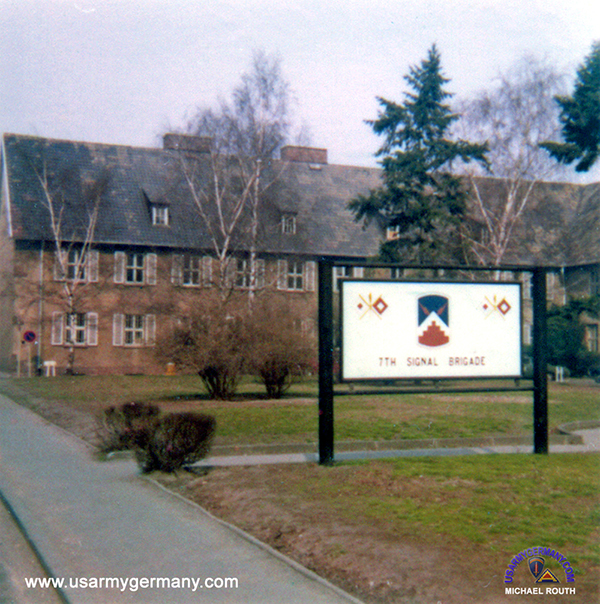 Headquarters 7th Signal Bde, Coleman Barracks, Sandhofen, early 1970s (Michael Routh) |
|||||||||||||||||||||||||||
| 1970 - present | |||||||||||||||||||||||||||
| (Source: Welcome Pamphlet, HQ 7th Sig Bde, early 1980s) | |||||||||||||||||||||||||||
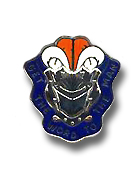 7th Signal Bde DUI
7th Signal Bde DUIThe 7th Signal Brigade, formerly the Seventh Army Communications Command (7ACC), was activated on 24 February 1970 and assigned the mission of providing tactical communications support for the United States Army, Europe and Seventh Army. This mission was previously performed by units with rich and varied experiences in tactical communications dating from the pre-World War II era, among which were: 160th Signal Group, 505th Signal Group, and the 7th and 12th Signal Groups. Originally, the 6,000 personnel who made up the command were organized under five Combat Area Signal Battalions: The 1st, 16th, 26th, 93d, 440th and the Army Signal Operation Battalion, the 97th, plus Company C, 25th Cable Construction Battalion. During 1967, the 69th Signal Company (PHOTO) and the US Army Tactical Data Unit were assigned. In 1968, Company C, 25th Cable Construction Battalion, and the Delta Companies of each of the five Combat Area Battalions were relocated to Fort Hood, Texas, as a part of REFORGER. On 15 July 1969, as a result of the Command, Control and Logistics Study-70, the 97th Signal Battalion was reassigned to CENTAG, a NATO organization. In its brief history of over nine years, the former 7ACC and 7th Signal Brigade has participated in over sixty field exercises, a substantial portion of which were major USAREUR-wide exercises. Outstanding communications support and achievement in communications reliability have been unparalleled in the history of tactical Signal operations, beginning with the first Signal Field Exercise, FRIGID FOREST, in February 1967, to the latest large-scale exercise, WINTEX 77, conducted in March 1977. In addition, the 7th Signal Brigade was given the task of introducing and testing the Tactical Automatic Digital Switch (TADS) and the Tactical Automatic Switch (TAS) for US Army, Europe, from February 1970 to present. There are presently two TADS switches in Europe, both operated by the 7th Signal Brigade. The 7th Signal Brigade also manages the TAS Network in Europe through its TASCO Office, located at Brigade Headquarters at Coleman Barracks. June 1972 brought about the reorganization of the 7th Signal Brigade into three Combat Area Signal Battalions consisting of a headquarters company and four lettered companies each. The 16th Signal Battalion colors were transferred to Fort Hood, Texas on 21 September 1972, and on the same date, the 93d Signal Battalion was placed in an inactive status. Effective 1 June 1975, the 72d Signal Battalion became OPCON to the 7th Signal Brigade, the 7th Signal Brigade became OPCON to the 5th Signal Command, and all USAREUR Communications-Electronics staff functions were absorbed by the 5th Signal Command. In 1978/79, 7th Sig Gp consisted of 4,000 soldiers organized into three Combat Area Signal battalions, one Command Signal battalion, one Cable Construction company, one Area Signal company and two Tactical Automatic Digital Switches (TADS): |
|||||||||||||||||||||||||||
|
|||||||||||||||||||||||||||
|
On
June 16 1990, 7th Sig Bde was reorganized as follows:
|
|||||||||||||||||||||||||||
|
|||||||||||||||||||||||||||
|
In
October/November 1991, the Brigade moved to Gerszewski Barracks,
Karlsruhe to improve its command and control over subordinate units.
Two of its battalions were already located in Karlsruhe, the other
two were in Kaiserslautern and Pirmasens.
|
|||||||||||||||||||||||||||
|
|||||||||||||||||||||||||||
|
7th
SIGNAL BRIGADE MISSION
The 7th Signal Brigade is a unique organization - there is no other like it in the Army. It is responsible for the tactical communications support of U.S. Army, Europe and 7th Army. The mission of the 7th Signal Brigade is to command, control, plan, engineer, install, operate and maintain the Army Command and Area Communications System for USAREUR and 7th Army. The major components of this tactical communications system are the Army Area Signal Centers (AASC), operated by the three Combat Area Signal Battalions, and command communications operated by the 72d Signal Battalion. The Combat Area Signal Battalions are assigned four lettered companies, each capable of installing an AASC. These AASC's might be thought of as a telephone and telegraph company providing communications for a small city. The AASC's are designed to serve the greatest number of subscribers. They provide not only telephone and teletype service, but air and motor messenger, radio-wire integration, and message center service to all units within their area of responsibility. The three Combat Area Signal Battalions - the 1st, 26th, 440th - and the 72d Signal Battalion provide the primary tactical communications and control facilities. They also provide USAREUR and 7th Army units with data communications and access into the worldwide Automatic Digital Network (AUTODIN). The 541st Cable Construction Company, attached to the 1st Signal Battalion, is the only unit of its type in Europe. All of these units combine to enable the 7th Signal Brigade to furnish the best possible tactical communications for USAREUR and 7th Army. |
|||||||||||||||||||||||||||
| If you have more
information on the history or organization of the 7th Signal Brigade,
please contact me |
|||||||||||||||||||||||||||
|
|
|||||||||||||||||||||||||||
| 1970 | |||||||||||||||||||||||||||
| (Source: Email from Pat Butler) | |||||||||||||||||||||||||||
I saw your site on the 7th Signal Brigade and really enjoyed it since I was assigned to the 7th from 1970-72. After reading it over I found that one unit is missing and that being the Tactical Data Unit (TDU). This unit was responsible for several Digital Subscriber Terminal Equipment (DSTE) sites within central Germany and did the acceptance testing of the Tactical Automatic Switch (TAS) Gerszewski Barracks in 1971 and later when they moved to Darmstadt and Heilbronn and went on-line.
The current history of the 7th is very interesting since when I arrived in Germany in July 1970 I was assigned to Signal Service Bn 4 at Neureut Kaserne in Karlsruhe. In November 1970 I was transferred to the 7th Signal at Coleman Barracks and after a few days of waiting around we found out that 20-25 of us were to go to Bremerhaven to pick up some equipment, which we later found out was the first two TADS. We got to drive the 12 trucks off of the Navy Roll-on Roll-off ship. The next morning we formed up with with several tankers, a wreaker, and several command vehicles and drove the trucks to Gerszewski Barracks were the TADS were setup and acceptance testing with Burroughs Corporation employees, began. In the spring of 1971, I think, several of us were to report back to Coleman Barracks were 7 of us were sent to setup a DSTE site at Fliegerhorst Kaserne, outside Hanau, in support of the 122nd Maintenance Bn. In spring of 1972 I was reassigned to the 93rd Signal Bn in Darmstadt were I worked in the S3 section in support of the TADS and DSTE sites. In April 1972 I was sent back to the states were I was discharged. |
|||||||||||||||||||||||||||
| 1971 | |||||||||||||||||||||||||||
| (Source: STARS & STRIPES, May 21, 1971) | |||||||||||||||||||||||||||
| The 7th Signal Bde, headquartered at Coleman Bks, Sandhofen, is responsible - in wartime - to link HQ 7th Army with V and VII Corps. There are five signal battalions under the 7th Bde. The Army Area Signal Centers set up by the companies of the various signal battalions are linked to each other by 90-foot line-of-sight LOS) antennas. Each antenna can transmit its beam up to 25 miles (under the best of conditions). When AASC's are separated by more than 25 miles they use radio relay sites to relay the transmission to the distant signal center. A company has 20 of the 90-foot antennas. It takes four men about 90 minutes to set up one antenna. Each AASC uses its own power sources (generators). The van-mounted switchboards at each center can accomodate 220 phone subscribers. The article describes a typical phone call between two subscribers using the network during a field exercise, SFX Carbineer Signal in May 1971: |
|||||||||||||||||||||||||||
|
|||||||||||||||||||||||||||
| 1981 | |||||||||||||||||||||||||||
| (Source: The Word, December 1981) | |||||||||||||||||||||||||||
| Aviation Airborne members of 7th signal provide vital link to secure mission accomplishment Field training exercises require units of the 7th Signal Brigade to be mobile. While most of the brigade goes to the field in jeeps and trucks, others fly. Although not highly publicized, the brigade's Aviation Section is fully committed during each field exercise also. Their responsibilities, which vary from mission to mission, can include courier service to the sites, VIP shuttles and RETRANS support. |
|||||||||||||||||||||||||||
|
|||||||||||||||||||||||||||
The daily inspection of each aircraft, part of the responsibilities of the crew chief, takes at least two hours, accordIng to PFC Cris L. Taylor, crew chief on a Huey (UH-1H) helicopter. Taylor explained, "The birds cannot fly without the daily inspection. We daily the aircraft before the pilot's pre-flight inspection." "We correct minor problems on the spot, although when a serious malfunction is detected we deadline the aircraft." Many hours of maintenance are required to keep the aircraft flying. The ratio of maintenance hours to actual flying hours illustrates the work involved in keeping the aircraft ready. CW03 Michael B. Syverson, Aviation Maintenance Officer, stated that five hours of maintenance are required for every hour of flying for the Hueys and EU-21 twin-engine airplanes. The ratio is four to one of the OH-58 helicopter. Because of the specialized services provided by the brigade's Aviation Section many people are unaware of the work and extra hours put in by personnel working there. Thanksgiving was a day off for most of the soldiers in the brigade. But to many personnel in aviation it was just another working day. As Taylor said, "I had to fly Thanksgiving and I won't be surprised to be working during the Christmas holidays. It's just a sacrifice we make to be doing something that we really love flying.". |
|||||||||||||||||||||||||||
| 1982 | |||||||||||||||||||||||||||
| (Source: The Army Communicator, Winter 1982 issue) | |||||||||||||||||||||||||||
| All US Army Signal assets above corps level in the European Theater are under the command and control of a single communications manager, Brig. Gen. Norman E. Archibald, commander, 5th Signal Command. The final step in pulling all these signal functions together under a single commander was the transfer of command of the 7th Signal Brigade from HQ USAREUR/7A to the US Army Communications Command. The 7th Signal Brigade was constituted as a Field Army Area Signal Brigade in February 1970 when the Army doctrine called for fighting in field army echelons. Today, however, the field army doctrine has evolved into the Echelons Above Corps (EAC) doctrine. The mission of the 7th Signal Brigade has therefore evolved from supporting a field army to providing communications support in the field to the echelons above corps. With more than 2,700 professional communicators, the 7th Signal Brigade provides transportable field communications support using tactical signal equipment for the echelons above corps in Europe, including lateral communications support to NATO Headquarters such as the Central Army Group. In wartime, the 7th Signal Brigade would serve as one of the field communications units of the Theater Communications Command - Army, the 5th Signal Command, in the European Theater of Operations. The 7th Signal Brigade provides field access to a variety of fixed communications networks and systems including the Automatic Digital Network (AUTODIN), the Automatic Voice Network (AUTOVON), and the Secure Voice Network of the Defense Communications System, the garrison dial networks, commercial networks and other systems such as the German Bundeswehrgrundnetz. The brigade is composed of three signal battalions and one reinforced signal company. The 1st Signal Battalion is one of two area signal battalions in the brigade. This battalion provides area communications service and multichannel extension to supported headquarters. The battalion also provides digital subscriber terminal equipment capability to organizations it supports. The 44th Signal Battalion is the other area signal battalion in the brigade. The companies are stationed well forward and strategically dispersed as they provide major nodal points connecting HQ USAREUR to the US Corps in the European Theater. The battalion also operates two automated message switches. The two TYC-39s, Pre-Production Model TRI-TAC Switches, make the 44th the only tactical organization in the European Theater with the capability of automatic routing of tactical communications over transportable equipment. The 72nd Signal Battalion is the largest battalion in the brigade. It is a command operations signal battalion providing long-haul command communications systems linking HQ USAREUR with subordinate and supported commands. The battalion also provides HQ USAREUR with command operation terminal facilities. The battalion operates 12 of the low-rate initial production models of the ground mobile force tactical satellite terminals. E Company, 67th Signal Battalion is also assigned to the brigade. It is a reinforced area signal company providing field communications support to US Forces stationed in the northern portion of Germany. Working with members of the 5th Signal Command is nothing new for members of the 7th Signal Brigade since the brigade has been functioning under the operational control of the commander, 5th Signal Command. Col. Jack Hammett. commander, 7th Signal Brigade, recently said, "To be successful in combat we must integrate the fixed and tactical systems. Without close teamwork this integration effort is futile. The transfer of the 7th Signal Brigade to USACC is a positive move that will strengthen the teamwork that prevails in both organizations already." |
|||||||||||||||||||||||||||
| 1989 | |||||||||||||||||||||||||||
| (Source: TOWER ECHO, April 1989) | |||||||||||||||||||||||||||
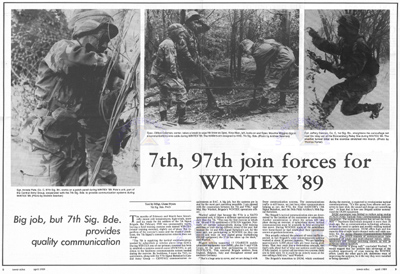 7th Signal Brigade participated in WINTEX '89 (557 KB) |
|||||||||||||||||||||||||||
| Emergency Deployment Communications Network | |||||||||||||||||||||||||||
| Related Links: 1st Circus/1st Signal Battalion - great site dedicated to 1st Signal Bn and Kaiserslautern (Broken LINK) |
|||||||||||||||||||||||||||
|
|||||||||||||||||||||||||||
